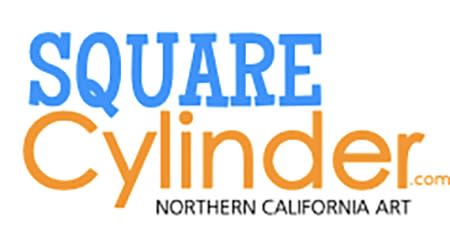By Emily Davis Adams
Is it possible to translate someone else’s experience accurately? This is the question at the heart of two concurrent exhibitions of the work of Julio César Morales. “Ojo” (at the Shrem) is a mid-career survey, while “My America” (at Norris) is a more selective presentation of new watercolors and a light and sound installation. These related exhibitions reveal that the great impact of Morales’ work stems from its insistence that communication solely through language is incomplete. With his restless deployment of media in a by-any-means-necessary approach to artmaking, Morales mobilizes the creative process with stories of the immigrant experience, splintering the fixed borders of language.
The title “Ojo” appears several times throughout the show, for example on a sign in a 1938 Dorothea Lange photograph, which according to the artist is the first known documentary image of Mexicans crossing the border. In “Ojo, Los Extranjeros (El Paso, 1938)” (2025) Morales presents three copies of Lange’s photograph behind sheets of brightly colored Plexiglas and next to a hand-painted replica of the work’s eponymous headline. A Google translation of the phrase produced “beware foreigners,” but at the exhibition’s opening curator Rachel Teagle asked her audience, including many native and fluent Spanish speakers, what ojo meant to them. “Watch out” and “Pay attention” were among the answers. Teagle noted that the expression can serve as an “informal command,” one exchanged between friends who are looking out for one another.
Morales, who grew up near the U.S.-Mexico border, first in Tijuana, then “a few blocks away” in San Diego, has thus far dedicated his career to work that reveals, as Guillermo Gómez Peña has put it, that “the multifaceted nature of the U.S. Mexico border demands a multidimensional perspective” (“English is Broken Here: Notes on Cultural Fusion in the Americas,” with Coco Fusco, 1995). The Plexiglas “intervention” in “Ojo, Los Extranjeros” is just one example of Morales’ aesthetic language, which features visual superimposition into historical source material. Selecting from an archive of historical borderland documentation that he has accumulated over the years, every work in Morales’ varied output translates these artifacts into stories through visualized music. He uses the rhythm of image repetition and electronic sound, the fragmented overlay of color and design, and the material and metaphorical meaning of his media to tell an alternate story rather than the conventional one.
Morales’ storytelling through mediumistic upending is present in both exhibitions, in the series, “Undocumented Interventions” (at the Shrem) and “Gemelos” (translated as “Twins,” at Norris). Each series presents delicate watercolor illustrations of attempted border crossings made from found footage of moments of discovery by border patrol. “Undocumented Interventions” highlights gut-wrenching images of children concealed inside piñatas. In “Gemelos,” Morales returns to the subject with pairs of immigrants hiding in the trunks of vehicles. In each work, two bodies intertwine within a single, womblike enclosure. Faces are rendered in a simplified and formulaic style reminiscent of early Renaissance — in particular Sienese — depictions of biblical characters. The lack of detail eliminates identification, so the images of the oppressed and vulnerable cannot fall prey to commercial exploitation. Rather, like the work of those Italian masters, simplification and lovingly rendered form along with a repetition of imagery allows for stories of violence and struggle to be shared across the centuries. As Morales said, “it is a harsh story told in the gentlest of mediums.”
Like “Ojo,” the word “Gemelos” in the context of Morales’ exhibitions is an open invitation to translate through experience. Predictably, Google Translate flattens and deracinates the word, presenting pictures of smiling blond lookalike girls. But in “My America” gemelos is so many other things. It is both the artist’s personal history and the two men in the trunk of a car. It is language itself, with all of its perpetual dualities and contradictions. It is the viewers inside the installation, built for pairs, where the undulating sound of the subwoofer has the two moving in sync. Gradually, the rhythm of the music suggests tires on a road while the space grows warm with shared breath.
Morales describes himself as a “musician whose instrument is art.” We embrace music that tells stories of struggle, sometimes brutal, when they are smuggled into the vehicle of harmony and rhythm. Think of Billie Holiday’s “Strange Fruit” or Rage Against the Machine’s “Killing in the Name of.” Morales’ work operates at this level, and most effectively so in his video and installation work, which brings together many of his tools and effects: found footage, light, music, color, drawing, movement, abstraction, and collaboration with other artists. It adds up to a singular experience that extends our perspective into that of others.
Outside the entrance of the museum, Morales has built a large installation related to “My America.” Hanging on a wood scaffold, large gothic lettering in blaring red neon reads: “Tomorrow is for those who can hear it coming.” What may seem to many a sinister warning sign, this is actually a hopeful message that was authored by David Bowie in 1977.
In its resistance to glib, polarizing rhetoric, there is power in Morales’ art and politics. The fractured aesthetic interventions that overlay and interweave within his imagery avoid didacticism or obscurantism. Unwilling to surrender to the cynical or cater to the popular or hyperlocal, Morales’ work conveys welcome. This work is an antidote to guardrail-free politics, offering a profound opportunity to learn through listening and looking, through bypassing the stranglehold that language alone can wield over our perceptions of one another. In Morales’ gentle protest, translation indeed seems possible. Even today.




